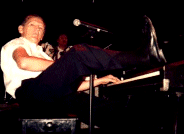Expressive piano playing is great for the audience but risky for the performer.
Your Back Page scribbler is happy to say he misspent a great many hours of his youth in the pursuit of learning to play the guitar.
Despite only obtaining a degree of expertise generously described as mediocre, it was time well spent in our eyes, and apart from calloused fingertips and an aching wrist, it certainly didn’t do us too much harm.
The same cannot be said, however, for folks who acquire mastery of the piano – that’s if a study by researchers at the University of Montreal is to be believed.
Publishing in the journal Frontiers in Psychology, boffins from the Canadian university’sSchool of Kinesiology and Physical Activity Sciences have examined the biomechanics involved in an expressive tickling of the keyboard and their findings may well hit a bum note for fans of the eighty-eight.
According to our researchers, bashing out a tune on the old Johanna involves more than just using the hands, but instead can involve the entire body from the torso to the fingers.
What’s more, this whole-of-body action heightens the risk of self-inflicted long-term injury, with the study reporting that 72% of pianists suffer from musculoskeletal disorders.
To deconstruct the performance biomechanics of keyboard-playing, our researchers fitted two professional pianists with 17 movement sensors.
The musicians then played six excerpts from classical and romantic works under two very different sets of performance conditions: an expressive reading, comparable to a live concert, and a more “neutral” one, in which the musicians were told to play strictly what was written in the sheet music, with no personal interpretation allowed.
The sensors were used to analyse three specific criteria: the amplitude of the pianists’ joint movements, the postures they adopted and the smoothness of their wrist movements.
What they found was that when pianists play expressively, this musical expression manifested itself physically throughout the body.
And while this engagement of the core muscles could reduce the risk of musculoskeletal disorders in this region, the piano players’ wrists spent more time in non-neutral and static positions, potentially increasing the chance of injury.
“We also found that the wrist movements become jerkier and less smooth when pianists play expressively, especially in more lyrical passages,” the researchers said in the study.
“This may constitute an additional risk factor because jerkiness involves quicker changes in the forces exerted on the joints.”
This excessive or improper wrist use could result in issues such as tendinitis or carpal tunnel syndrome.
“These disorders, which are so common among musicians, could undermine a pianist’s career if these factors are not taken into account in practice routines and prevention measures,” the study authors said.
“Pianists seeking to reconcile high-level performance and good health should be made aware of how important it is to manage movements properly. Integrating mobility exercises, adapted stretching and body awareness into practice routines could make a real difference.”
Or they could incorporate hitting the keyboard with their feet as well as their hands. That worked out pretty well for Jerry Lee Lewis.

Send sonatas and story tips to grant@medicalrepublic.com.au.


